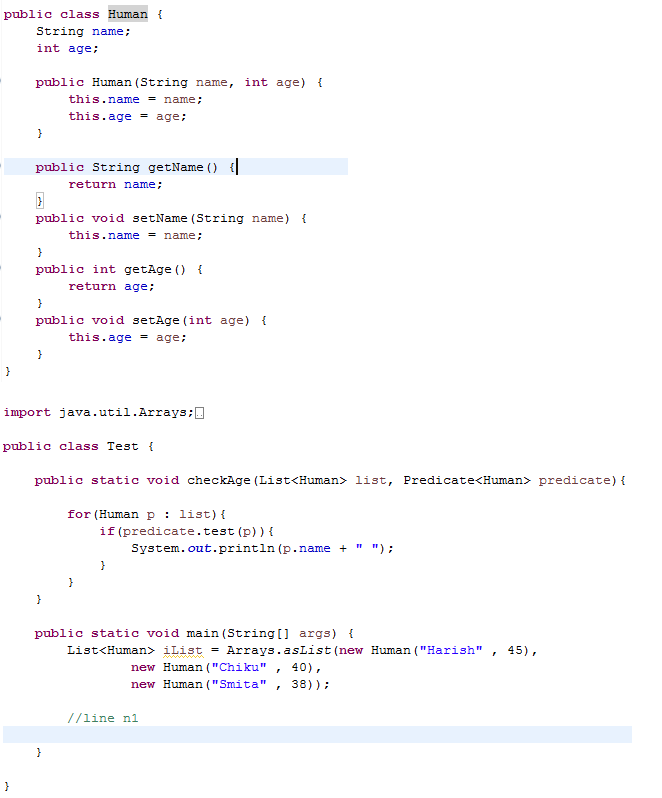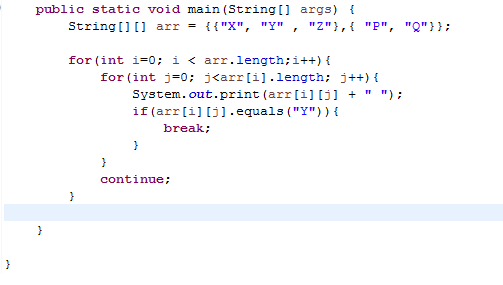Oracle Java Programming Certification Questions and Answers (Dumps and Practice Questions)
Question : Which code fragment, when inserted at line n,
enables the code to print Harish?

1. checkAge (iList, ( ) -> p. get Age () > 40);
2. checkAge(iList, Person p -> p.getAge() > 40);
3. checkAge (iList, p -> p.getAge() > 40);
4. checkAge(iList, (Person p) -> { p.getAge() > 40; });
Correct Answer : 3
Explanation:
Question : Given the code snippet :
When you run this code, what will be printed

1. X Y Z
2. X Y Z P Q
3. X Y P Q
4. Compilation Error
Correct Answer : 3
Explanation:
Question : Please look into , given code fragement.
Select the correct options which will be printed out.

1. true true
2. true false
3. false false
4. false true
Correct Answer : 3
Explanation:
Related Questions
Question : You have been given below code
public class Triangle {
static double area;
int b = 2, h = 3;
public static void main(String[] args) {
double p, b, h; // line n1
if (area == 0) {
b = 3;
h = 4;
p = 0.5;
}
area = p * b * h; // line n2
System.out.println("Area is " + area);
}
}
What is the result?

1. Area is 6.0
2. Area is 3.0
3. Access Mostly Uused Products by 50000+ Subscribers
4. Compilation fails at line n2
Question : Given the code fragment:
public class Test {
public static void main(String[] args) {
// line n1
switch (x) {
case 1:
System.out.println("One");
break;
case 2:
System.out.println("Two");
break;
}
}
}
Which three code fragments can be independently inserted at line nl to enable the code to print one?
A. Byte x = 1;
B. short x = 1;
C. String x = "1";
D. Long x = 1;
E. Double x = 1;
F. Integer x = new Integer ("1");

1. A,B,F
2. C,D,E
3. Access Mostly Uused Products by 50000+ Subscribers
4. D,E,F
Question : You have been given below code, what would be printed when you run it.
public class App {
public static void main(String[] args) {
Boolean[] bool = new Boolean[2];
bool[0] = new Boolean(Boolean.parseBoolean("true"));
bool[1] = new Boolean(null);
System.out.println(bool[0] + " " + bool[1]);
}
}

1. True false
2. True null
3. Access Mostly Uused Products by 50000+ Subscribers
4. A NullPointerException is thrown at runtime
Question : You have been given two separate classes as below.
public class MyException extends RuntimeException { }
public class Test {
public static void main(String[] args) {
try {
method1();
} catch (MyException ne) {
System.out.print("A");
}
}
public static void method1() { // line n1
try {
throw Math.random() > 0.5 ? new MyException()
: new RuntimeException();
} catch (RuntimeException re) {
System.out.print("B");
}
}
}
What is the result?

1. A
2. B
3. Access Mostly Uused Products by 50000+ Subscribers
4. AB
5. A compile time error occurs at line n1
Question : You have been given Java Application as below code
public class App {
String myStr = "7007";
public void doStuff(String str) {
int myNum = 0;
try {
String myStr = str;
myNum = Integer.parseInt(myStr);
} catch (NumberFormatException ne) {
System.err.println("Error");
}
System.out.println("myStr: " + myStr + ", myNum: " + myNum);
}
public static void main(String[] args) {
App obj = new App();
obj.doStuff("9009");
}
}
What happen/print, when you execute this code ?

1. myStr: 9009, myNum: 9009
2. myStr: 7007, myNum: 7007
3. Access Mostly Uused Products by 50000+ Subscribers
4. Compilation fails
Question : Which two are benefits of polymorphism?
A. Faster code at runtime
B. More efficient code at runtime
C. More dynamic code at runtime
D. More flexible and reusable code
E. Code that is protected from extension by other classes

1. A,B
2. B,C
3. Access Mostly Uused Products by 50000+ Subscribers
4. C,D
5. A,E